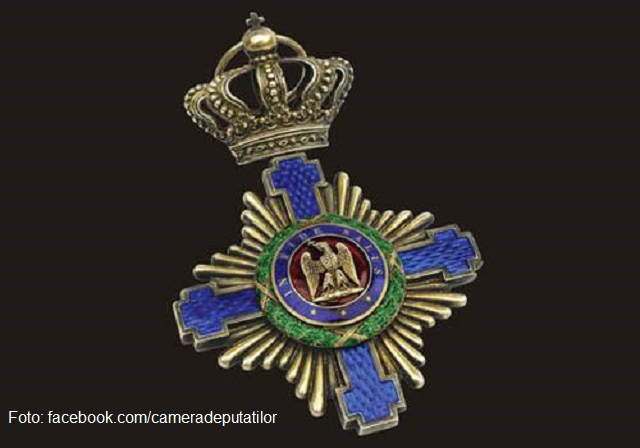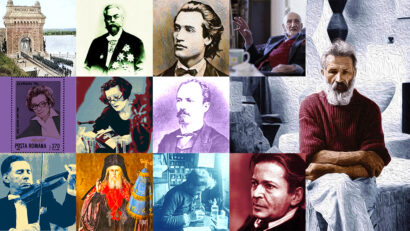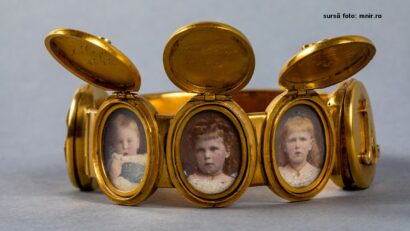Orders and decorations of Romania
A short history of decorations in Romania

Steliu Lambru, 09.05.2020, 14:00
States,
institutions and organizations in general are used to expressing their
recognition for people’s special service by awarding distinctions. Romania has
always rewarded those who have distinguished themselves through special
personal merit with orders and medals. Phaleristics is the auxiliary science of
history and numismatics that studies medals, orders and other decorations. A
quick overview will tell us more about their history in Romanian space. Thus,
Romanian distinctions are broken down in national decorations, commemorative
decorations, military decorations in times of peace, military decorations in
times of war, civilian decorations for various fields of activities and
honorifics.
The first
Romanian decoration ever to be documented appears in the second half of the 19th
century, after the unification of the Principalities of Moldavia and Wallachia.
Under the reign of the first ruler of the Romanian United Principalities,
Colonel Alexandru Ioan Cuza, the Romanian State made its first attempts at
establishing orders and decorations. In 1860, Cuza founded the Military Virtue
Medal (Pro Virtute Militari) to
reward the firefighters who had fought the Ottomans on Dealul Spirii battle of
September 13, 1848. In 1864, Cuza wanted to establish the Order of the Union
(Ordinul Unirii), which would mark 5 years since the Union of the
Principalities, but eventually gave up the idea, fearing it might stir up
tensions with the Ottoman Empire. Another two medals, the Military Virtue
(Virtutea militară) and Devotion and Courage (Devotament și Curaj), were meant
to reward acts of bravery in the field of battle, a battle that resulted in a
great loss of lives during the War of Independence of 1877-1878. In 1864, two
years before stepping down, Cuza created the Romanian Star (Steaua României)
national order, which was to become the highest distinction of the Romanian
state. Floricel Marinescu, an expert in phaleristics, talked more about the
first decorations of Romania.
As bestowing
orders is a prerogative of sovereign states only, Romania did not have a
national order before the proclamation of independence, in May, 1877. Cuza’s
previous attempts at creating a distinction were met with opposition by the
Ottoman Empire and the Austrian Empire, which saw this undertaking as Romania
earning some rights that only sovereign states were entitled to. Hence the
decorations Cuza commissioned remained unbestowed at the royal palace.
Cuza’s
successor, Prince Carol I of Hohenzollern-Sigmaringen, helped build a
full-fledged modern state. Romania’s prerogatives as a sovereign state became
transparent gradually during his rule, and were confirmed after the War of
Independence. Although coerced by the Ottomans not to bestow any distinctions,
Carol played a smart game, steering the country towards independence. He
carried over his predecessor’s attempts at establishing decorations and actually
saw them through. One of these decorations with be the Military Virtue
(Virtutea MIlitară). The proclamation of independence of May 10, 1877 marked
the establishment of the first Romanian order, the Romanian Star (Steaua
României), which had five ranks: knight, officer, commander, commanding officer
and the Great Cross. The Romanian Star was an echo of the Order of the Union
Cuza had failed to create as an official distinction of the Romanian modern
state. New distinctions emerged after the independence: the Crossing of the
Danube (Trecerea Dunării) Cross, the Elizabeth Commemorative Cross, named
after Queen Elizabeth, also known as the Mother of the Wounded, wife to King
Carol I, the Defenders of the Independence (Apărătorii Independenţei) Medal
and the Faithful Service (Serviciul Credincios) Medal. Also worth mentioning
is that Russia, Romania’s ally in the war against the Ottoman Empire, gave
distinctions to Romanian soldiers, such as the Russian Medal for the Turkish
War of 1877-1878 and the Saint George Cross. Russian military were in turn
decorated with the Crossing of the Danube Cross. Professional distinctions
included the Fruit of Labor in Education Medal, awarded to teaching staff,
while in 1906 the Fruit of Labor for the Church was created, offered to the
clergy. The Bravery and Faith Medal was created in 1903, awarded to police
officers. Over 1912-1913 new medals were introduced: the Commercial and
Industrial Merit Medal, the Military Service Reward Medal, for reconscripted
soldiers, the Glory of the Country medal for military who had taken part in
the second Balkan war of 1913 and the Health Merit Cross. Floricel Marinescu
says Romania developed a genuine system of distinctions after gaining the
independence:
Other orders
come into being over the years: in 1991, the ‘Romanian Crown’, then in 1906 the
King Carol I’ order. Like other orders in the world, their number was strictly
limited to members in the country. During the First World War and under the
rule of Carol I, a whole series of orders, medals and crosses was created,
which made up a well-rounded system. You could be rewarded for any type of
activity, with a wide range of ranks. All these decorations disappeared in
1948, with the abolishment of the monarchy.
After the Second
World War, Romania switched to the Soviet system of distinctions, from their
form and names to the fact that they could be bestowed infinitely. The value of
medals was therefore lost, due to the large number of those actually wearing
them, and to the ideology and propaganda circulated. The most prominent
distinctions in communism were the Star of the Socialist Republic of Romania
and the Hero of Socialist Labor in the Socialist Republic of Romania Award.
These too vanished after the anti-communist revolution of 1989. Romania’s
current system of national orders was reintroduced in 1997 and, to a certain extent,
restored the system used up until 1989.
(Translated by
V. Palcu)






























